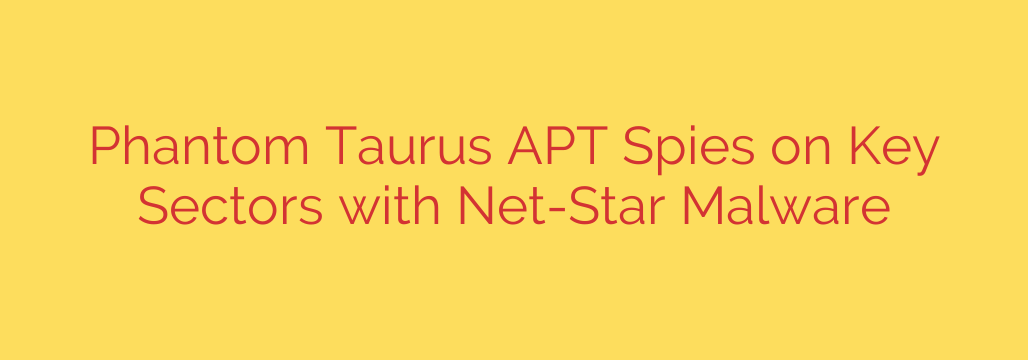
Unmasking Phantom Taurus: A Deep Dive into the Net-Star Espionage Malware
A sophisticated cyber espionage campaign is actively targeting high-value organizations across the Middle East and Africa, deploying a new and stealthy malware known as Net-Star. The threat actor behind these operations, identified as Phantom Taurus (also known as WIRTE), is a persistent group known for its focus on intelligence gathering from government, military, diplomatic, and financial sectors.
This campaign highlights the evolving tactics of Advanced Persistent Threat (APT) groups and underscores the need for robust, multi-layered security defenses.
The Attack Chain: How Net-Star Infiltrates Systems
The infection begins with a classic but effective technique: a carefully crafted spear-phishing email. These emails are designed to look legitimate, often referencing topics relevant to the target organization to entice the recipient into opening a malicious attachment.
The typical attack unfolds in the following stages:
- The Lure: The victim receives an email containing a weaponized Microsoft Office document, such as a Word file.
- The Trigger: The document prompts the user to “Enable Content” to view it properly. This action executes hidden malicious macros embedded within the file.
- The Downloader: Once enabled, the macros run a script (typically a VBScript) that acts as a downloader. This script reaches out to a command-and-control (C2) server controlled by the attackers.
- The Payload: The script downloads the final payload—the Net-Star malware—and executes it on the victim’s system, establishing a persistent foothold for the attackers.
Inside Net-Star: A Modern Information Stealer
Net-Star is a .NET-based malware specifically engineered for reconnaissance and data exfiltration. Its primary mission is not to disrupt operations or demand a ransom, but to silently collect and steal sensitive information over an extended period.
Key capabilities of the Net-Star malware include:
- System Reconnaissance: Upon execution, the malware gathers detailed information about the infected system, including the operating system version, computer name, and username. This data helps the attackers understand the target environment.
- Screen Capture: Net-Star can take screenshots of the victim’s desktop, allowing attackers to view sensitive documents, emails, and credentials that may be open on the screen.
- Sensitive File Exfiltration: The malware is programmed to search the system for files with specific extensions, such as .doc, .docx, .xls, .xlsx, and .pdf. It then compresses these files and sends them back to the attacker’s C2 server.
The Art of Evasion: Using DNS Tunneling for Covert Communication
One of the most sophisticated aspects of this campaign is how Net-Star communicates with its C2 server. The malware uses DNS tunneling, a technique that hides malicious traffic within legitimate-looking DNS queries.
Because DNS traffic is essential for internet functionality, it is often trusted and less scrutinized by firewalls and other network security tools. By disguising its C2 communications as standard DNS requests, Net-Star can effectively bypass many traditional security solutions, allowing it to send stolen data and receive new commands without raising alarms.
How to Protect Your Organization: Actionable Security Measures
Defending against threats like Phantom Taurus and the Net-Star malware requires a proactive and layered security strategy. Organizations, especially those in targeted sectors, should prioritize the following defensive measures:
- Enhance Email Security: Deploy advanced email security solutions that can detect and block malicious attachments, scan for phishing indicators, and sandbox suspicious links before they reach the end-user.
- Educate Your Team: Conduct regular security awareness training to help employees recognize the signs of a phishing attack. Emphasize the danger of enabling macros from untrusted or unexpected email attachments.
- Harden Endpoints: Configure Microsoft Office applications to disable or restrict macros by default. Ensure all systems are equipped with reputable endpoint detection and response (EDR) solutions that can identify and block malicious script execution.
- Monitor Network Traffic: Pay close attention to DNS traffic for unusual patterns. Implementing DNS monitoring and security solutions can help detect anomalies indicative of DNS tunneling.
- Maintain a Strong Patching Cadence: Keep all operating systems, applications, and security software up to date to protect against vulnerabilities that attackers could exploit.
The activities of Phantom Taurus are a stark reminder that cyber espionage remains a significant threat to critical infrastructure and government bodies. By understanding their tactics and implementing robust security controls, organizations can significantly reduce their risk of compromise.
Source: https://securityaffairs.com/182852/apt/china-linked-apt-phantom-taurus-uses-net-star-malware-in-espionage-campaigns-against-key-sectors.html








